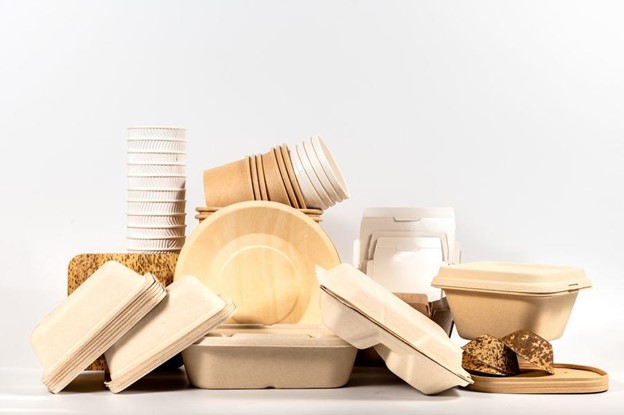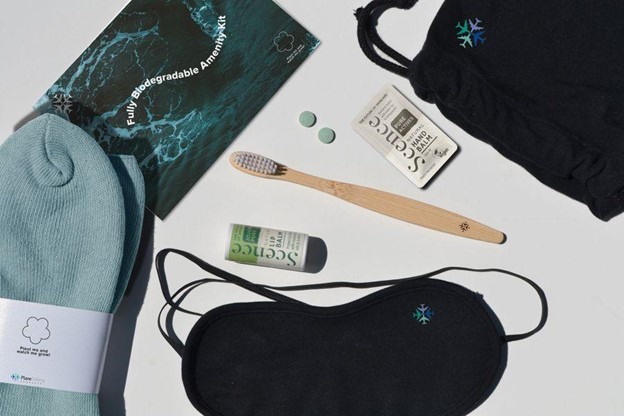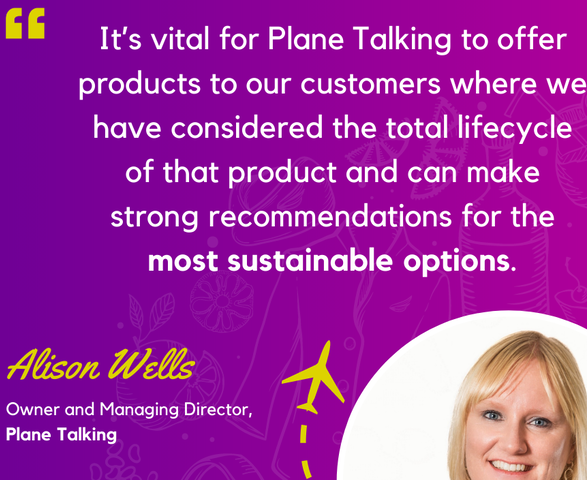Sustainability in the travel catering and onboard services sector is no longer a flight of fancy but a necessity across the entire supply chain. To meet both corporate responsibility and customers’ needs, sustainable growth has encouraged airline carriers to invest in product ranges to deliver on these expectations.
The team spoke with Alison Wells, Managing Director at Plane Talking Products Limited to discuss how onboard suppliers are meeting this challenge.
What is the current issue of sustainability onboard?
As Wells sees it, “this is the hottest topic for us right now and has been for a number of years. Sustainability permeates everything we are doing – it has to.” Nowhere, perhaps then, does it stand to affect more components, people, communities and landscapes than across the onboard supply chain.
What is the supply chain?
Simply put, “a supply chain is a network of individuals and companies who are involved in creating a product and delivering it to the consumer.” And as much as 90% of a company’s total environmental footprint can be made up across its supply chains. This is, of course, significant as it also means that a conscious move towards a sustainable supply chain represents an area of potential for transformative change.
But a holistic approach needs to be taken. Wells states that “it’s vital for Plane Talking to offer products to our customers where we have considered the total lifecycle of that product and can make strong recommendations for the most sustainable options.”

This must consider everything from the materials used, where / how they are sourced, production processes, transportation and so on. A truly sustainable supply chain will be one that uses environmentally and socially sustainable practices at every stage.
“If we are serious about making significant, future-proofed progress then the entire supply chain has to come together to drive real change.” And this means the industry has to “go way beyond simple concepts of recycling and reuse – it’s a different world now.”
Whether the onboard industry is quite there yet, though, is a work in progress. In other areas of aviation sustainability, for example, large steps towards net zero and carbon neutrality targets have been taken. Take the Fly-i programme which uses “physical supply chain data” for the tracking and optimisation of sustainable aviation fuel (SAF) for airline carriers.
In contrast, as Wells sees it, whilst “progress has been made onboard there is still much more to do.” This is not to say, however, that this progress is insignificant. Nor do the driving factors behind this need for change appear to be letting up.
What is driving sustainable changes in the onboard sector?
Wells maintains that “a number of factors are behind the change.” These include:
Climate change: “This can’t be ignored. We see it every day on the news and in our own weather patterns. Consumers expect a response.”
Consumers: “There is an expectation today, in all aspects of our lives that we expect to see efforts being made to move to far more sustainable products and services across the board.”
The circular economy: “This is a difficult area for our sector given the strict regulation around the treatment of certain cabin waste but we must continue to try.”
Net Zero targets and decarbonisation: “We have to act in order to meet the target set by governments across the world.”

And of course, there are the airlines themselves to consider. “They face the same pressure from consumers, legislation and so on. They are looking for supply partners who can help them on their sustainability journeys.”
Consequently, this is where shows like WTCE are key in bringing together like-minded airlines and suppliers with the same goals in mind. “Coming together at an event like WTCE is so important – we need to unite so we can discuss and make significant sustainable change a reality in our sector.”
How does this affect onboard suppliers and businesses?
Wells is right when she mentions that the industry needs to “come together”. The road to sustainability onboard is continually driving nascent change, including strategic partnerships.
One such example is airline catering and retail specialist LSG Group partnering with onboard solutions provider Kaelis. Together, they are aiming to optimise supply chain networks to “enhance efficiency, reduce costs, and improve airline operational support”.
For Plane Talking Products, on the other hand, they’ve “developed product ranges in a number of areas in recent years that perhaps, we wouldn’t have previously considered.” For example:
Material selection. Onboard suppliers are being pushed to stay up to date with innovation and material options across various manufacturing processes. Whether it’s biodegradable amenity kits or the use of materials like bagasse and bamboo fibre, the industry is constantly seeking alternatives. “There are many plastic alternatives these days and many more in development stages. We are also making more use of natural fibres and natural waste fibres.”
Thinking local
Guaranteeing same-quality standards across the supply chain naturally lends itself to thinking more locally. Wells concurs, stating that “offering something that is made from locally grown or produced materials, is clearly a good thing.” But, where that is not always viable, “we also aim to offer our customers choices. We try to always include a locally sourced option, if it’s practical to do so.”

This flexibility has to be maintained as a consideration also. It’s not always possible, or economically viable (to suppliers or airlines) to opt for the most sustainable option. Of course, “we can agree that using something more than once has to be better, we also have to accept that sometimes in our industry that simply isn’t practical.” For Wells, this manifests itself as always being ready to “ask that question and challenge the thought process behind our decisions.”
End of life/circular solutions
“Plane Talking wants to help our customers to think through the disposal of our products carefully.” One big issue, especially with non-recyclable cabin waste, where this, by law, has to go to landfill or be burned. How Wells, among others, wants to ask is — can this be avoided?
How can sustainability be upheld across company values?
Material selection, recycling and employing circular economies across the supply chain are all pieces of the sustainability jigsaw. On working these beliefs into the core of Plane Talking Products, Wells maintains that “sustainability is front and centre of our company’s value proposition.” Among other steps taken, they have “achieved ISO14001 last year.” The company has also “joined the Net Zero Nation Accelerator Programme” and is “looking more deeply into our scope 3 greenhouse gas emissions and are committed to making more sustainable choices.”
But companies must also consider their social sustainability — their impact on workers and communities not only “at home” but wherever they operate across the supply chain. For Wells, it seems, it is not only embedded in product design but also their “staff, operations, and the way we conduct our business.”
How can onboard companies become more sustainable?
Taking this into consideration, onboard suppliers also need to look to the future of talent in this sector. From both a hirer and interviewee perspective, sustainability is becoming increasingly relevant for recruiting. “It’s about setting the right culture and tone in your business and leading by example. It’s important to recruit people who care about the environment – who want to be sustainable in general terms.”
And, while this can often be “more difficult in larger organisations”, change has to start somewhere. “With these goals embedded in a company’s vision, values and personal/company objectives,” Wells assures us, “it becomes far easier to drive through change because everyone is onboard with the journey.”

How can sustainability become a priority across the supply chain?
With the necessary steps towards a sustainable supply chain clearly laid out, it begs the question — how to initiate? Returning to the strength of strategic partnerships, Delta Air Lines is one carrier which has partnered with EcoVadis in a bid to integrate sustainability into its entire business strategy. For Plane Talking Products, says Wells, “we specify more sustainable materials, look at production processes, consolidate freight where possible and do our best to achieve as streamlined a supply chain as possible. Our designers and buyers are focused on challenging the supply chain to operate in a more sustainable way.”
However, “there is much work to be done in terms of finding the balance between cost parameters and being more sustainable.” Consequently, the associated cost of becoming more sustainable may be at risk of being absorbed by passengers. As such, the question arises as to how they’re benefitting from the change they’re driving.
Of course, it is not only airline passengers who are, indeed, driving change. Wells concurs, “it’s not only what our customers want but what we want to see in our own business.” Still, it can’t be denied that data shows that nearly one in three consumers are willing to boycott a given brand to help protect the environment. Additionally, sustainability may be even more of a concern among younger generations.
It has been recorded that Gen Zers are also more ready to spend more money on sustainably-made consumer items. This, critically for the onboard sector, relates first to food and beverage, followed closely by beauty and care products. For airlines, “working with suppliers who are on the Net Zero journey with them will help them reach their own targets.”
And the impact of visible sustainable onboard items “is also critical” to passenger perception, says Wells. “We know there is a lot of work going on with SAFs but the passenger cannot see this. What they can see, and touch are the inflight products and services, so making sure this is properly considered with regards to sustainability is a critical driver for choosing to fly with a particular airline.”
Challenges to sustainability
With a clear roadmap to sustainability onboard and strong steps being taken in the onboard sector, Wells sees two core challenges to the road ahead:
Knowing where to look to make sustainable choices: Materials, processing, logistics, service and disposal.
Cost: Despite the need for sustainability onboard, “the most sustainable choices are not usually the lowest cost.” And the parameters as to who absorbs this cost may vary.
Thinking in a positive vein, Wells states that sustainable processes and items onboard can only be a victim of their success. Indeed, “the more prevalent some of these new innovative materials become”, the more costs stand to come down. As to getting carriers to overcome the allure of a lower price point at the cost of sustainability, Wells is resolute. “Attitudes are changing.”
Learn more about sustainable onboard offerings at WTCE:

